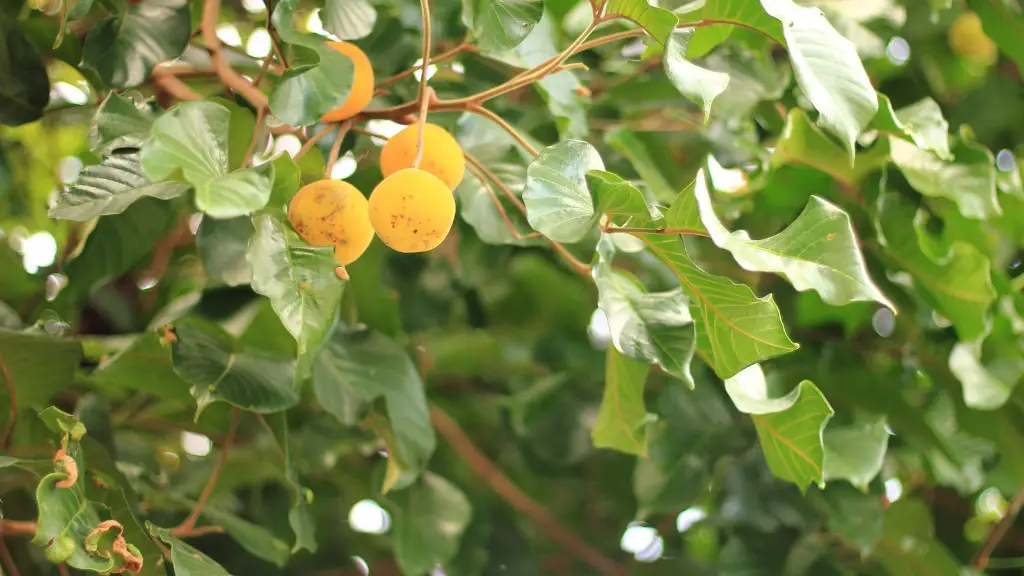What Causes Avocado Trees to Drop their Fruits?
Many avocado owners experience the disappointment of coming across fallen fruits beneath their healthy-looking trees. While some people may assume this is a sign of tree damage, the reality is often more complex. A range of environmental and physiological conditions can lead to the fruit of a tree being shed.
Although uncommon, it is possible that the loss of fruit from an avocado tree may be a sign of a deficiency in elements required for healthy growth. The most commonly affected elements are nitrogen, phosphorous, potassium and calcium. Trees unable to access enough nutrients can produce flowers, but may drop immature fruits as a survival mechanism.
In some cases, damaged roots caused by an insect infestation or physical distrubance may prevent proper absorption of elements needed for fruit growth. Additionally, if a tree has become unbalanced in terms of its pruning and fertilizing, it can start to shed fruit. If a tree is not properly maintained and undesirable fruits appear, their removal can help arrest the loss of more fruit in the future.
Temperature fluctuations, extreme weather and fungal infections can also cause fruit loss. Generally, when the temperature drops beyond optimal levels, the plant may be unable to form and mature its fruit. High winds, heavy rain and extreme heat weaken the internal structure of the fruit, making it susceptibile to dropping. At the same time, trees with weak branches may not be able to support healthy, heavy fruits.
What Can Be Done to Support an Avocado Tree?
The best way to support an avocado tree is to provide it with proper care and monitoring. It is important to dilute chemical fertilizers before applying them to the tree, and to maintain a consistent fertilizing schedule. This can help the avocado access the key nutrients it needs for healthy growth.
The tree should also be watered correctly according to its age, size and environmental conditions. If a tree is getting too much or too little water, it might struggle to survive. Additionally, pruning the tree at the appropriate time, providing pest control and ensuring the tree is growing in an area with the correct temperature can all help to maintain the health and vibrancy of the tree.
Finally, monitoring the tree from time to time can help identify any issues early, while they are still able to be corrected. Furthermore, owners need to ensure they are following expert advice on the type of care and growing environment suitable for the specific variety of avocado they are planting.
What Are the Consequences of Fruit Dropping?
Often the repercussions of an avocado tree dropping fruit can be difficult to predict, however, there are a few key impacts to be aware of. When a tree drops its fruit, the intensity of future seasons of fruit production may be diminished. Some varieties of avocado may also be weakened, providing less viable and plentiful fruit yields going forward. This means that the size and/or quality of the fruit produced may also drop accordingly.
With this in mind, it is important to expose the eco-system that the tree is part of to a healthy balance of soil pH, light and water. These factors, combined with suitable fertilization and pruning, can create an environment in which the tree can thrive. Additionally, severely diseased trees should be removed, given that their health and productive potential is often diminished.
How Can an Avocado Tree Recover From Drops?
The good news is that avocado trees are generally hardy and resilient, and are often able to recover quickly from dropping fruit. Depending on the severity and cause of the drops, it is often possible to implement restorative tactics to successfully revive and establish a healthy tree. After ensuring the tree is in a position to access the key elements it requires, it is important to monitor, prune and fertilize it with care. A healthy diet and balanced eco-system can encourage an avocado tree to begin to flower and fruit again, while generous watering can also help to stimulate robust, healthy fruits.
What Long-Term Measures Can Be Taken?
Taking a proactive approach can be the most successful way to battle the issue of fruit dropping on an avocado tree. Not all varieties of avocado will be suitable for the climate or other environmental conditions in which they are being grown. In some cases, using a range of different varieties may be required in order to equip the tree to handle certain external shocks, such as an infestation or extreme weather conditions. Additionally, it can help to use organic fertilizers and suitable soil enhancers, such as compost.
In some circumstances, it may also be helpful to deploy newer irrigation systems, such as a drip system, to help ensure the water is distributed evenly throughout the soil. This can help to ensure the tree gets the right amount of hydration and that it is not being over or under watered. Furthermore, due to its ability to reduce damage caused by extreme heat, cold and wind, it can be recommended to plant the avocado tree in a sheltered area of the garden, where it is more likely to grow well.
How Can I Prevent Avocado Trees From Dropping their Fruit?
The key to a healthy, fruit-producing avocado tree is to cultivate an environment in which the tree has ready access to nutrients, water and moderate temperatures. Fertilizers and soil enhancers can help a tree become strong and well-nourished, while thorough monitoring and pest control can help to ensure it is not being attacked.
Finally, as well as providing a suitable climate and environment for the tree, it is important to pay attention to the guidelines specific to the variety of avocado which is being grown. Consulting with a professional tree specialist or local nursery may also be useful in obtaining the correct advice for each individual tree.
Conclusion
When the fruits of an avocado tree start to drop, it can be a warning signal of an imbalance within the tree. The key to reducing the issue of dropped fruit is to provide proper care and fertilization, tailored to the individual needs of the tree. Understanding the external environment and conditions in which the tree is planted can help to create the optimum setting for healthy development, allowing for an abundant and full harvest.


